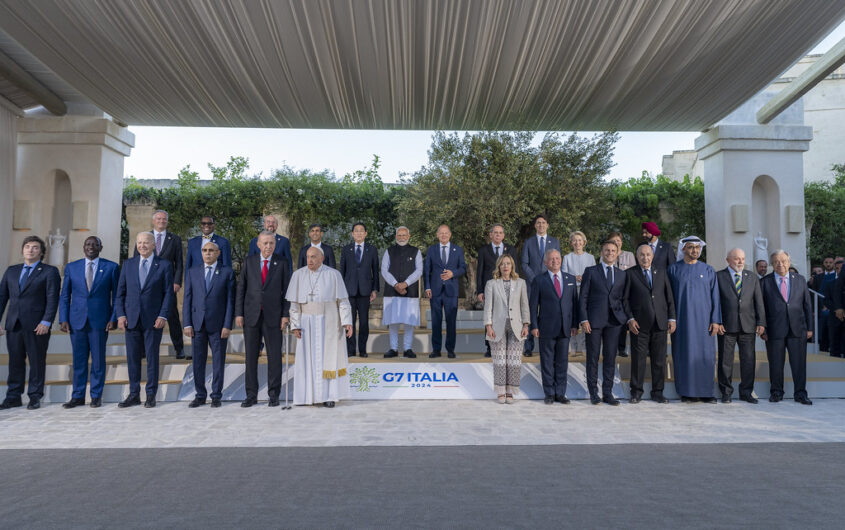
The White House via Flickr
The G7 Summit and the Two Worlds of Geoeconomics and Geopolitics

Peter S. Rashish
Vice President; Director, Geoeconomics Program
Peter S. Rashish, who counts over 30 years of experience counseling corporations, think tanks, foundations, and international organizations on transatlantic trade and economic strategy, is Vice President and Director of the Geoeconomics Program at AICGS. He also writes The Wider Atlantic blog.
Mr. Rashish has served as Vice President for Europe and Eurasia at the U.S. Chamber of Commerce, where he spearheaded the Chamber’s advocacy ahead of the launch of the Transatlantic Trade and Investment Partnership. Previously, Mr. Rashish was a Senior Advisor for Europe at McLarty Associates, Executive Vice President of the European Institute, and a staff member and consultant at the International Energy Agency, the World Bank, UN Trade and Development, the Atlantic Council, the Bertelsmann Foundation, and the German Marshall Fund.
Mr. Rashish has testified before the House Financial Services Subcommittee on International Monetary Policy and Trade and the House Foreign Affairs Subcommittee on Europe and Eurasia and has advised three U.S. presidential campaigns. He has been a featured speaker at the Munich Security Conference, the Aspen Ideas Festival, and the European Forum Alpbach and is a member of the Board of Directors of the Jean Monnet Institute in Paris and a Senior Advisor to the European Policy Centre in Brussels. His commentaries have been published in The New York Times, the Financial Times, The Wall Street Journal, Foreign Policy, and The National Interest, and he has appeared on PBS, CNBC, CNN, NPR, and the BBC.
He earned a BA from Harvard College and an MPhil in international relations from Oxford University. He speaks French, German, Italian, and Spanish.
The G7 summit that took place on June 13-15 in Borgo Egnazia, in the southeastern Italian region of Puglia, may be remembered by historians as a turning point. Not for the substance of its deliberations: compared to last year’s Hiroshima G7—which unveiled, defined, and endorsed the concept of “economic security”—this year’s gathering was more about continuity than innovation.
Instead, the Italian G7 clarified two elements of economic statecraft that will be required of the leading Western powers as the world undergoes its greatest transformation in 80 years. First, to renew the weakened global economic order they will have to enlarge their tight-knit G7 club to a wider group of countries. And second, they will have to find a way for two separate geoeconomic and geopolitical tracks to coexist on the road to an updated rules-based international system.
Looking at this year’s leaders’ communiqué it becomes clear that sometimes the context is more important than the text. Yes, there was robust language about pushing back against unfair Chinese policies, including its overcapacity in electric vehicles, which is the subject of separate U.S. and EU trade actions.
It was more the dynamics and the timing of the G7 summit than anything memorialized by the written word that communicate its strategic significance.
There was also a commitment to addressing “energy security, climate crisis, and geopolitical risk” as a “holistic” challenge, which is a recognition of the reality that the green transition could be upended by asymmetric dependencies on unreliable suppliers. That security-first idea was balanced by an integration-minded acknowledgment of “the important role of trade in addressing global environmental challenges, including [WTO] plurilateral initiatives such as those facilitating and promoting trade in environmental goods, services, and technologies.”
But it was more the dynamics and the timing of the summit than anything memorialized by the written word that communicate its strategic significance. In addition to the seven regular members (Canada, France, Germany, Italy, Japan, the UK, and the United States as well as the EU), Brazil, Turkey, India, Argentina, Algeria, Kenya, and Tunisia were also at this year’s G7.
The presence at the summit of these members of what is sometimes referred to as the “Global South” is a recognition that the G7 countries (who comprise under 30 percent of global GDP) will need the help of like-minded economies from more diverse geographies and levels of economic development to renew the global economic order—to deal with trade, climate, and technology—in a way that is both effective and inclusive.
But there is also an important lesson for the G7 from what took place over the same weekend: the Ukraine Peace Summit in Switzerland. At that gathering, Brazil was only an observer while several full participants, including Saudi Arabia, India, South Africa, Thailand, Indonesia, Mexico, and the United Arab Emirates, chose not to sign the final communiqué.
All G7 countries are either NATO members or a U.S. treaty ally, and since the mid-1980s, its summits have regularly addressed geopolitical issues in addition to core economic concerns. But a wider, more heterogeneous membership will almost certainly require the G7 to accept that some countries, some of the time may only wish to endorse the geoeconomic aspects of its recommendations.
That may not be ideal, but it is also a necessary concession to realism. Renewing the global economic order—for example, to promote alternatives to China’s economic practices—is a core national interest for the G7 countries, as much as maintaining international peace and security. In the future, a diversity of views on geopolitics within an enlarged G7 will need to be tolerated as the condition for the important work of building consensus on geoeconomics.








